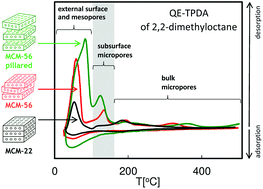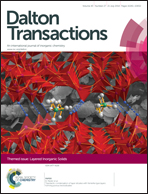Application of quasi-equilibrated thermodesorption of linear and di-branched paraffin molecules for detailed porosity characterization of the mono-layered zeolite MCM-56, in comparison with MCM-22 and ZSM-5†
Abstract
The pore characteristics of zeolite samples including two kinds of ZSM-5 crystals as a base case and the unique mono-layered MCM-56 in different structural forms have been studied by the new method QE-TPDA (quasi-equilibrated temperature-programmed desorption and adsorption) in comparison with the standard nitrogen adsorption. Both approaches produce consistent results in terms of micro- and meso-porous features as well as quantitative pore volume values. The benefits of QE-TPDA include fast data acquisition (hours) and small sample size (milligrams). It is very flexible in using various hydrocarbons as probe molecules, which may reveal additional details associated with pores, their internal environment and dimensions/shape of the sorbate molecules. Hence, QE-TPDA is a valuable complementary tool for porosity characterization of the ever increasing diversity of porous materials and their pore structures. This was demonstrated by the results for the desorption of nonane and 2,2-dimethyloctane (DMO). The latter showed an additional maximum in the intermediate temperature range (between ‘micro-’ and ‘mesopore’ regions) which could be attributed to adsorption in the subsurface micropores (i.e. the pore mouths) where DMO could be partially adsorbed with t-butyl groups remaining on the outside. This was also reflected in the discrepancy between apparent volumes of micro- and mesopores calculated from the nonane and DMO experiments. Pillared MCM-56 revealed visibly enhanced subsurface micropore adsorption compared to the parent (mono-layer MWW) and MCM-22 (multi-layered MWW) consistent with the expected increase in the content of external 12 ring surface cups.

- This article is part of the themed collection: Layered Inorganic Solids

 Please wait while we load your content...
Please wait while we load your content...